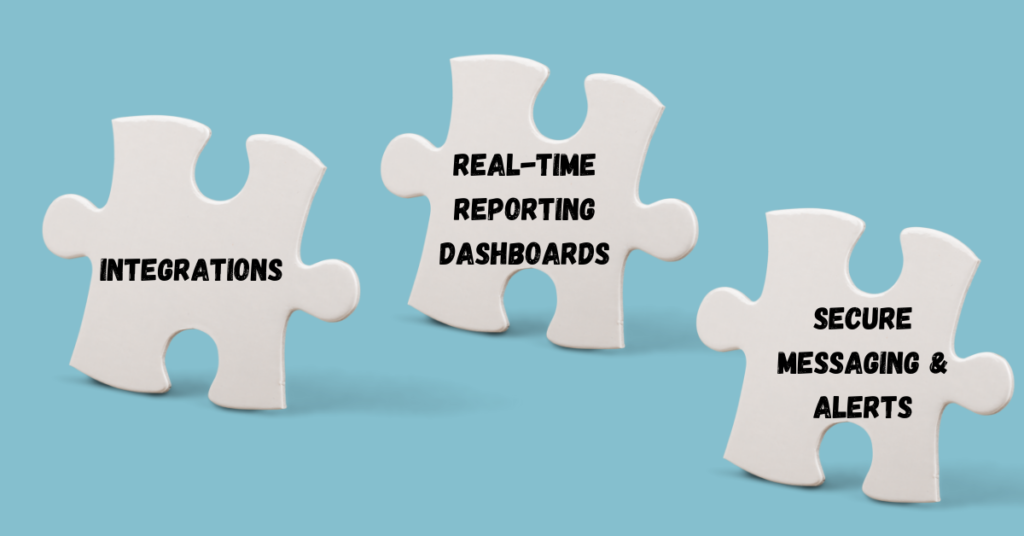Clinical communication and collaboration, or CC&C, is vital in healthcare. It has a tremendous impact on the patient experience and most importantly, patient safety. This in turn impacts a provider’s reputation. Even if the desired outcome is achieved, such as a successful surgery, poor communication and collaboration can lead to frustration for patients during the care process. These adverse effects of poor clinical communication and collaboration include:
- Unclear or improper procedure prep instructions
- Scheduling delays or postponements
- Increased patient fear and anxiety due to confusion and uncertainty
That’s why hospitals turn to clinical communication and collaboration platforms – to manage the communication and care process. CC&C platforms encompass a variety of software, such as EHR’s. No CC&C platform is complete though. In this blog, we’ll look at some things that may be missing from your clinical communication and collaboration platform.
Integrations
One roadblock to clinical communication and collaboration is a lack of integration between systems. No matter how innovative a solution may be, if it doesn’t integrate with the EHR, EMR, and other parts of the CC&C platform, it can slow down the entire process. For instance, if an ambulatory order management solution isn’t integrated with the EHR, the order information may need to be entered multiple times to ensure order accuracy and transparency; once in the order management solution itself, and again in the EHR. Not only does this take extra time and resources, but this duplicate entry also increases the chance of mistakes being made.
When selecting components of your clinical communication and collaboration platform, ask potential vendors how their solution integrates with your EHR, EMR, and other third party solutions. Additionally, check out these 3 essential EMR integrations for healthcare practices according to Solution Partner.
Real-Time Reporting and Dashboards
Another feature that may be missing from your clinical communication and collaboration platform is real-time reporting and analytics dashboards. Data is critical in healthcare, and it often needs to be analyzed in real-time. CC&C platforms pull in data from various sources, providing insights into such things as bed capacity, waiting room times, call frequency and on-hold times, order volumes, and more. If this data isn’t displayed in real-time and in a clear manner, such as in dashboards, the clinical communication and collaboration process can be impeded.
Read this case study on how UCHealth used real-time reporting dashboards in bed management to gain care improvements and cost efficiencies.
Secure Messaging and Alerts
The final feature that may be missing from your clinical communication and collaboration platform is secure messaging and alerts. Messaging is obviously a core component of communication and collaboration, and with a rise in cyber attacks against health systems and the need to comply with HIPAA, secure messaging is imperative.
Equally important is an alert system that promptly notifies applicable parties, such as patients, schedulers, and doctors of important information. If applicable parties aren’t promptly alerted during the care process, treatment could be delayed, errors could be made, and patients and their loved ones may experience increased anxiety and frustration. Needless to say, this can all lead to a negative patient experience.
In addition to adding these missing pieces to your clinical communication and collaboration platform, learn more about how collaboration can impact the patient experience in this blog.
Strengthening Your Clinical Communication and Collaboration Platform

We’ve covered the importance of a clinical communication and collaboration platform, as well as three features that may be missing from yours: integrations, real-time reporting and data dashboards, and secure messaging and alerts. At iPro Healthcare, we have a solution that checks all those boxes (and more) and can strengthen your CC&C platform: iOrder ambulatory order management.
iOrder is an ambulatory order management solution that generates an electronic order, eliminating faxes, reducing back-and-forth calls, and ensuring complete order transparency. A built-in clinical decision support mechanism, or qCDSM, validates orders for accuracy, reducing errors and treatment delays, ensuring patient safety, and maximizing reimbursement. iOrder integrates with EHR’s and many third-party vendors, ensuring seamless interoperability. iOrder also features real-time reporting dashboards, ensuring your team has all the information they need at their fingertips.
Finally, iOrder features a messaging and alert system that is secure and HIPAA compliant. The appropriate parties are securely alerted when an order comes in and when the results are ready. Ronnie Sutton, Director of Software Services at iPro Healthcare explains how iOrder’s security works:
The reverse proxy is the main piece of security. We use HTTPS to send the web request to the proxy server, which then passes it on to the Web API. The API authenticates the message and if the username and password credentials are correct, it processes the web request into the program.
Ronnie Sutton, Director of Software Services, iPro Healthcare
If you’d like to learn more about how iOrder can strengthen your clinical collaboration and communication platform, contact us today.




